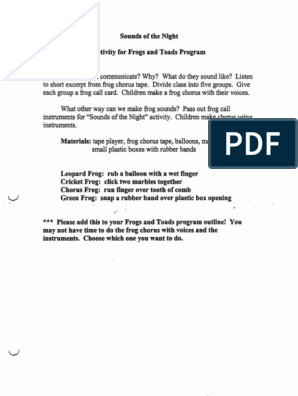0% found this document useful (0 votes)
95 views38 pagesBiology Toad 1
Here are the answers to the questions:
1. Toads and frogs are amphibians because they can live on both land and water. They have moist skin for respiration and lay their eggs in water.
2. Two other amphibians are salamanders and newts.
3. The nictitating membrane protects the outer surface of the eye of the toad.
4. The function of the tympanic membrane in the toad is to detect sound vibrations/hear.
5. Three functions of jelly around the eggs of the toad/frog are:
- Protect the eggs from infection
- Enable the eggs to float on the water surface
- Prevent predators
Uploaded by
yhivithefairyCopyright
© © All Rights Reserved
We take content rights seriously. If you suspect this is your content, claim it here.
Available Formats
Download as PPTX, PDF, TXT or read online on Scribd
0% found this document useful (0 votes)
95 views38 pagesBiology Toad 1
Here are the answers to the questions:
1. Toads and frogs are amphibians because they can live on both land and water. They have moist skin for respiration and lay their eggs in water.
2. Two other amphibians are salamanders and newts.
3. The nictitating membrane protects the outer surface of the eye of the toad.
4. The function of the tympanic membrane in the toad is to detect sound vibrations/hear.
5. Three functions of jelly around the eggs of the toad/frog are:
- Protect the eggs from infection
- Enable the eggs to float on the water surface
- Prevent predators
Uploaded by
yhivithefairyCopyright
© © All Rights Reserved
We take content rights seriously. If you suspect this is your content, claim it here.
Available Formats
Download as PPTX, PDF, TXT or read online on Scribd
/ 38























































































